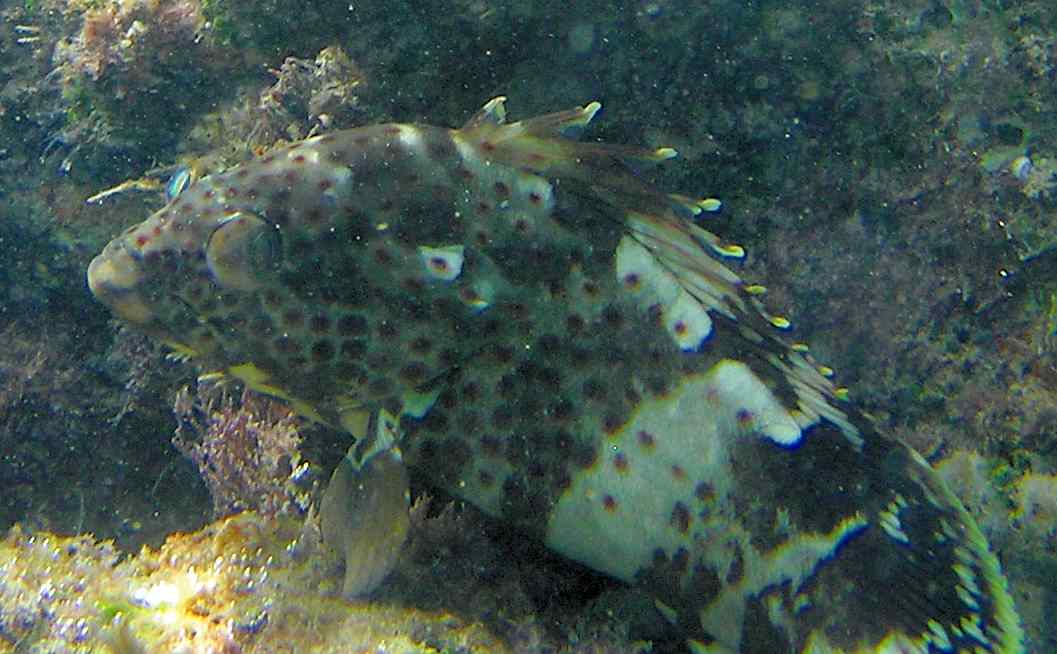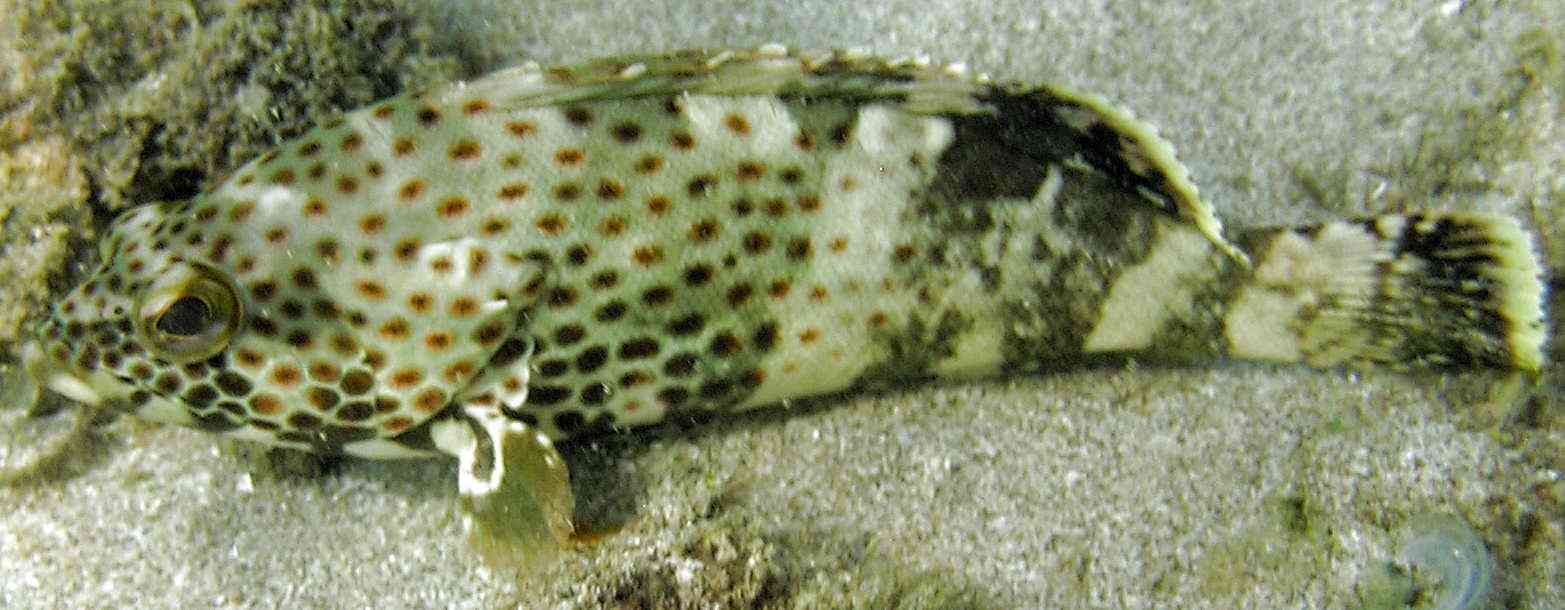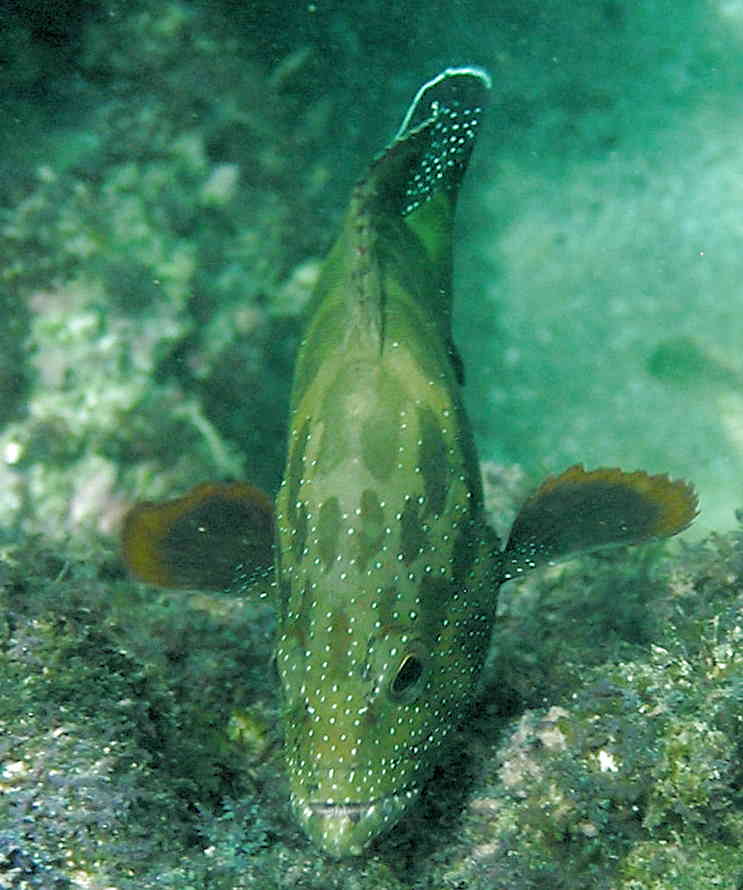zurück Übersicht
Getarnter Zackenbarsch
Epinephelus polyphekadion
zurück
vor


Pfauenaugen Zackenbarsch

The
Getarnter Zackenbarsch, known in English as the
Camouflaged Grouper or
Camouflage Grouper, is a species
of grouper (family
Serranidae) found in tropical
marine environments. The term "getarnter" translates to "camouflaged" in German,
referring to the fish’s ability to blend into its surroundings.
Key Characteristics and Features:
1.
Appearance
- The
Camouflaged Grouper has a
stocky, robust body typical of groupers. Its coloring and patterning are
designed for camouflage.
-
Coloration: They usually have a mix of
brown,
green, and
gray tones, with darker
markings or spots that help them blend in with the rocky or coral-laden
environments they inhabit.
-
Camouflage: As the name suggests, these fish are well-camouflaged,
which helps them avoid predators and ambush prey. Their mottled patterns
make them difficult to spot among the rocks, coral, or sandy bottoms of
their habitat.
2.
Habitat
- Camouflaged groupers are generally
found in reef environments—particularly
in coral reefs,
rocky outcrops, and
sand flats.
- They thrive in
tropical and subtropical waters
of the Indo-Pacific region, including areas like the
Red Sea,
Indian Ocean, and parts
of the Pacific Ocean.
3.
Diet
-
Carnivorous: Like other
groupers, camouflaged groupers are predatory fish. They have a diet that
includes smaller fish, crustaceans, and other marine invertebrates.
-
Ambush Predators: These
fish often rely on their camouflage and patience. They wait for prey to come
near and then quickly strike, using their large mouths to gulp down smaller
animals.
4.
Behavior
-
Solitary: Camouflaged
groupers are generally solitary
fish, although they may sometimes be seen near others in environments that
offer plenty of food.
-
Ambush Strategy: They
tend to lie in wait, using their camouflage to blend into their environment,
and ambush passing prey.
5.
Reproduction
- Like many groupers, the camouflaged
grouper has a seasonal spawning
cycle. They often gather in
spawning aggregations during certain times of the year.
- The fish release their eggs and sperm
into the water, where fertilization occurs externally. The fertilized eggs
develop into larvae and eventually settle to the seafloor to grow into
juvenile groupers.
6.
Conservation
- While not critically endangered, many
grouper species, including camouflaged groupers, are under pressure due to
overfishing, habitat degradation, and the impact of climate change on coral
reef systems.
-
Marine protected areas (MPAs)
and sustainable fishing practices are essential to preserving their
populations.
7.
Importance in Ecosystem
-
Predator: As a top
predator in its environment, the camouflaged grouper plays a crucial role in
maintaining the balance of the local ecosystem by controlling the
populations of smaller fish and invertebrates.
-
Indicator Species: The
health of grouper populations can serve as an indicator of the overall
health of the reef ecosystem. A decline in grouper numbers often signals
broader ecological issues.
Fun Facts:
-
Speed and Agility:
Although they rely on their camouflage, groupers are also capable of
quick bursts of speed
when chasing prey or avoiding predators.
-
Mouth Size: Groupers have
notably large mouths
relative to their body size, enabling them to gulp down large prey in one
go.
Conclusion
The Getarnter Zackenbarsch or
Camouflaged Grouper is a
fascinating and well-adapted fish, using its remarkable camouflage to survive
and thrive in the complex, competitive environment of coral reefs. Its behavior,
appearance, and role in the ecosystem make it an essential part of marine
biodiversity, though it faces ongoing threats from human activity.
 26.07.25 Copyright Dirk
Rauschenbach Koelnerstrasse 293 51702 Bergneustadt
Datenschutzerklaerung 02261 9788972 Mail ccooly(
at) web.de
26.07.25 Copyright Dirk
Rauschenbach Koelnerstrasse 293 51702 Bergneustadt
Datenschutzerklaerung 02261 9788972 Mail ccooly(
at) web.de
 Safaris
Bergsteigen
Wandern
Inselwandern Weltweit
Safaris
Bergsteigen
Wandern
Inselwandern Weltweit
 Europa
Inselwandern
Europa
Inselwandern
 Städtewandern
Städtewandern
 Paintings
Paintings Dirk Rauschenbach
Dirk Rauschenbach
 Safaris
Bergsteigen
Wandern
Inselwandern Weltweit
Safaris
Bergsteigen
Wandern
Inselwandern Weltweit
 Europa
Inselwandern
Europa
Inselwandern
 Städtewandern
Städtewandern
 Paintings
Paintings Dirk Rauschenbach
Dirk Rauschenbach
![]() 26.07.25 Copyright Dirk
Rauschenbach Koelnerstrasse 293 51702 Bergneustadt
Datenschutzerklaerung 02261 9788972 Mail ccooly(
at) web.de
26.07.25 Copyright Dirk
Rauschenbach Koelnerstrasse 293 51702 Bergneustadt
Datenschutzerklaerung 02261 9788972 Mail ccooly(
at) web.de